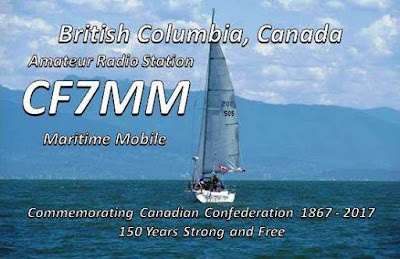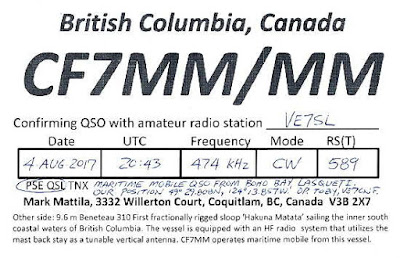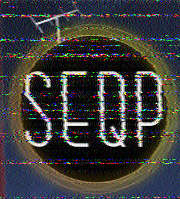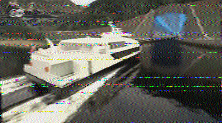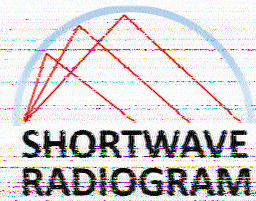 Amateur Radio Weekly – Issue 169
Amateur Radio Weekly – Issue 169
Solar Eclipse QSO Party
The SEQP will take place on August 21 from 1400 – 2200 UTC.
hamsci.org
VUARC Eclipse balloon project
AA4VU will fly three items in the balloon payload: Crossband repeater, APRS tracking unit, CW ID.
Vanderbilt University Amateur Radio Club
Pacific Hams to aid emergency response during eclipse
Alderman Steve Myers asked local hams to be on hand during the eclipse in case someone needs an ambulance or police during a cell tower overload.
Pacific Missourian
South Carolina Hams to aid emergency response during eclipse
There will be added voices over the air waves, aiding emergency response over the Total Solar Eclipse weekend.
WIS
Ham Radio Operators step up in good times and bad
Hams regularly volunteer their skills and expertise to coordinate responses in emergencies like the Boston Marathon bombing and when Hurricane Katrina devastated New Orleans.
Emergency Management
The 30m CW Interest Group
encourages CW activity on 30m to ensure that we do not lose this very special prime CW band to other modes, nor lose it to other primary services.
30cw.net
Using RUMlogNG for iOS with an Elecraft KX2 over Bluetooth
My goal is to build the project for under $35. I’m also planning to design my own PCB board and offer it as a kit.
VA2SS.com
A test of the saltwater effect using WSPR
The simultaneous reports showed a mean 10 dB SNR advantage for Vertical 1 at the shore.
N4KGL.info
ARRL finally realizes status quo isn’t going to cut it
Any “visioning” or strategic planning that doesn’t get the membership involved right from the start just isn’t going to work.
KB6NU.com
Parachute Mobile
In the Air, On the Air
Parachute Mobile
Thank a Ham radio operator today
Since the early 1900s, no other group has made a greater contribution to radio communications.
The Tribune
Video
RF Noise: Find the sources
Neighbors, street lighting, shopping malls plus much more. I have had a few QSOs on SSB when the propagation have been good and other stations have been strong so they have overthrown my QRM.
SA5LKC
HF signal propagation reporter
Where is your signal being heard? Is your antenna working? What is the status of the band? Check out this video to learn about the PSK reporter website and how it can benefit you.
HamRadioConcepts
Amateur Radio Weekly is curated by Cale Mooth K4HCK. Sign up free to receive ham radio's most relevant news, projects, technology and events by e-mail each week at http://www.hamweekly.com.
 A 630m Maritime Adventure
A 630m Maritime Adventure
| HAKUNA MATATA |
Crewed by Mark (VA7MM) and YL May (VA7MAY), Toby (VE7CNF) and XYL Nancy, the 31' Benateu recently completed a 14-day circumnavigation of Georgia Strait's Gulf Islands. This is a yearly adventure that has been successfully completed for the past few summers and looks as though it may now be an annual tradition.
Normally, the crew kept up regular radio contact on HF as well as on VHF when possible but this year saw a major departure.
In previous summers, near the end of the voyage, the crew has always visited us here on Mayne Island for an afternoon of vittles and libation before heading for home. There is always a good amount of time spent recalling the past-year's radio activities, winter projects and reminiscence of the 'good old days'. Last year, just as the party was ending, I jokingly suggested that 'next year', it would be cool to work them from the boat on 630m.
Although there was no immediate commitment, I knew that the seed had been planted, and with three of the four crew being engineers, I suspected it might be hard for them to resist, and ... just before departure, the local bunch of 630m ops were put on alert to be watching for CF7MM/mm on 475 kHz CW as they would be attempting to work us from three different overnight anchorages during their summer voyage!
Evidently Toby had been working quietly during the winter to make this become a reality. Here are some pictures of the system along with Toby's (the system's builder) comments.
| Variometer and matching transformer |
| Wire vertical and loading coil |
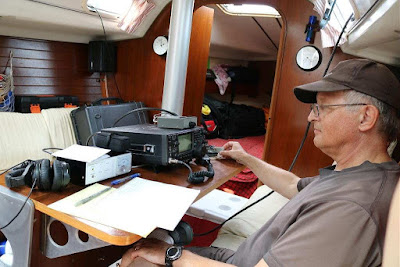 |
| Toby (VE7CNF) working the pileups! |
| Tuneup |
 |
| The route, heading north from Vancouver |
Some of the contacts are shown below. Note the transceiver is not really on 160m ... it's just the i.f. for my 630m transverter!
I was impressed with the strength of ground wave signals given the low transmitter powers and EIRP's well below 5W. Received signals ranged from S1 to S9+10dB and copy was easy for all QSOs. QSO distances ranged from 10 to 142 km. We had low receive noise levels in all locations, with Silva Bay being a little noisier than the others due to many nearby boats and some shore power lines.
We tried disconnecting the gunnel ground wires and leaving only the keel, and found that the antenna capacitance and resistance did not change. When we disconnected the keel and left only the gunnel wires, the antenna capacitance dropped to about 87pF and antenna resistance dropped by a few ohms. It appears that the keel provided most of our ground coupling to sea water and it would have been a sufficient ground on its own.
More details of Toby's 630m transverter as well as a practical 630m antenna tune-up procedure can be found on his website here.
All-in-all, I think the 630m operation was a great success and very likely the first-ever 630m marine mobile operation on that band, as I don't recall this happening anywhere else over the years. It was also a great way to pay homage to the band's original maritime heritage where its quality groundwave and skywave capabilities were used to advantage for so many decades safeguarding mariners worldwide.
Maritime mobile operation on the amateur bands has some great history behind it, including the yacht YASME. In the mid-50's, Danny Weil was the first ever amateur to undertake DX'pedition style operations via sailboat, as he visited numerous rare islands in the Caribbean and South Pacific.
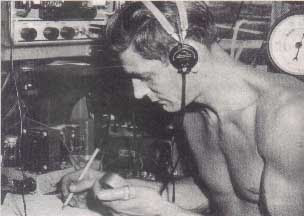 |
| Danny on the YASME - courtesy: www.gm3itn.co.uk |
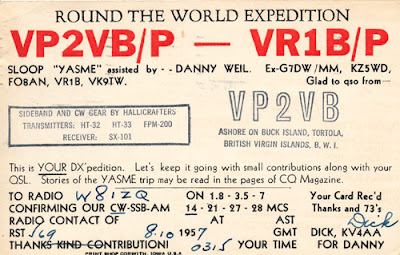 |
| Original YASME QSL - courtesy: http://hamgallery.com/ |
His exploits were regularly published in CQ magazine at the time and always made for exciting reading as Danny would eventually wreck three YASMES over the years! His adventures laid the groundwork for future island-hopping DX operations such as those undertaken by Gus Browning (W4BPD), Don Miller (W9WNV) and all that followed ... I'm sure they would all have enjoyed working the HAKUNA MATATA as well!
Steve McDonald, VE7SL, is a regular contributor to AmateurRadio.com and writes from British Columbia, Canada. Contact him at [email protected].
 A 630m Maritime Adventure
A 630m Maritime Adventure
| HAKUNA MATATA |
Crewed by Mark (VA7MM) and YL May (VE7MAY), Toby (VE7CNF) and XYL Nancy, the 31' Benateu recently completed a 14-day circumnavigation of Georgia Strait's Gulf Islands. This is a yearly adventure that has been successfully completed for the past few summers and looks as though it may now be an annual tradition.
Normally, the crew kept up regular radio contact on HF as well as on VHF when possible but this year saw a major departure.
In previous summers, near the end of the voyage, the crew has always visited us here on Mayne Island for an afternoon of vittles and libation before heading for home. There is always a good amount of time spent recalling the past-year's radio activities, winter projects and reminiscence of the 'good old days'. Last year, just as the party was ending, I jokingly suggested that 'next year', it would be cool to work them from the boat on 630m.
Although there was no immediate commitment, I knew that the seed had been planted, and with three of the four crew being engineers, I suspected it might be hard for them to resist, and ... just before departure, the local bunch of 630m ops were put on alert to be watching for CF7MM/mm on 475 kHz CW as they would be attempting to work us from three different overnight anchorages during their summer voyage!
Evidently Toby had been working quietly during the winter to make this become a reality. Here are some pictures of the system along with Toby's (the system's builder) comments.
| Variometer and matching transformer |
| Wire vertical and loading coil |
 |
| Toby (VE7CNF) working the pileups! |
| Tuneup |
 |
| The route, heading north from Vancouver |
Some of the contacts are shown below. Note the transceiver is not really on 160m ... it's just the i.f. for my 630m transverter!
I was impressed with the strength of ground wave signals given the low transmitter powers and EIRP's well below 5W. Received signals ranged from S1 to S9+10dB and copy was easy for all QSOs. QSO distances ranged from 10 to 142 km. We had low receive noise levels in all locations, with Silva Bay being a little noisier than the others due to many nearby boats and some shore power lines.
We tried disconnecting the gunnel ground wires and leaving only the keel, and found that the antenna capacitance and resistance did not change. When we disconnected the keel and left only the gunnel wires, the antenna capacitance dropped to about 87pF and antenna resistance dropped by a few ohms. It appears that the keel provided most of our ground coupling to sea water and it would have been a sufficient ground on its own.
More details of Toby's 630m transverter as well as a practical 630m antenna tune-up procedure can be found on his website here.
All-in-all, I think the 630m operation was a great success and very likely the first-ever 630m marine mobile operation on that band, as I don't recall this happening anywhere else over the years. It was also a great way to pay homage to the band's original maritime heritage where its quality groundwave and skywave capabilities were used to advantage for so many decades safeguarding mariners worldwide.
Maritime mobile operation on the amateur bands has some great history behind it, including the yacht YASME. In the mid-50's, Danny Weil was the first ever amateur to undertake DX'pedition style operations via sailboat, as he visited numerous rare islands in the Caribbean and South Pacific.
 |
| Danny on the YASME - courtesy: www.gm3itn.co.uk |
 |
| Original YASME QSL - courtesy: http://hamgallery.com/ |
His exploits were regularly published in CQ magazine at the time and always made for exciting reading as Danny would eventually wreck three YASMES over the years! His adventures laid the groundwork for future island-hopping DX operations such as those undertaken by Gus Browning (W4BPD), Don Miller (W9WNV) and all that followed ... I'm sure they would all have enjoyed working the HAKUNA MATATA as well!
Steve McDonald, VE7SL, is a regular contributor to AmateurRadio.com and writes from British Columbia, Canada. Contact him at [email protected].
 AmateurLogic 12th Anniversary Sweepstakes
AmateurLogic 12th Anniversary Sweepstakes
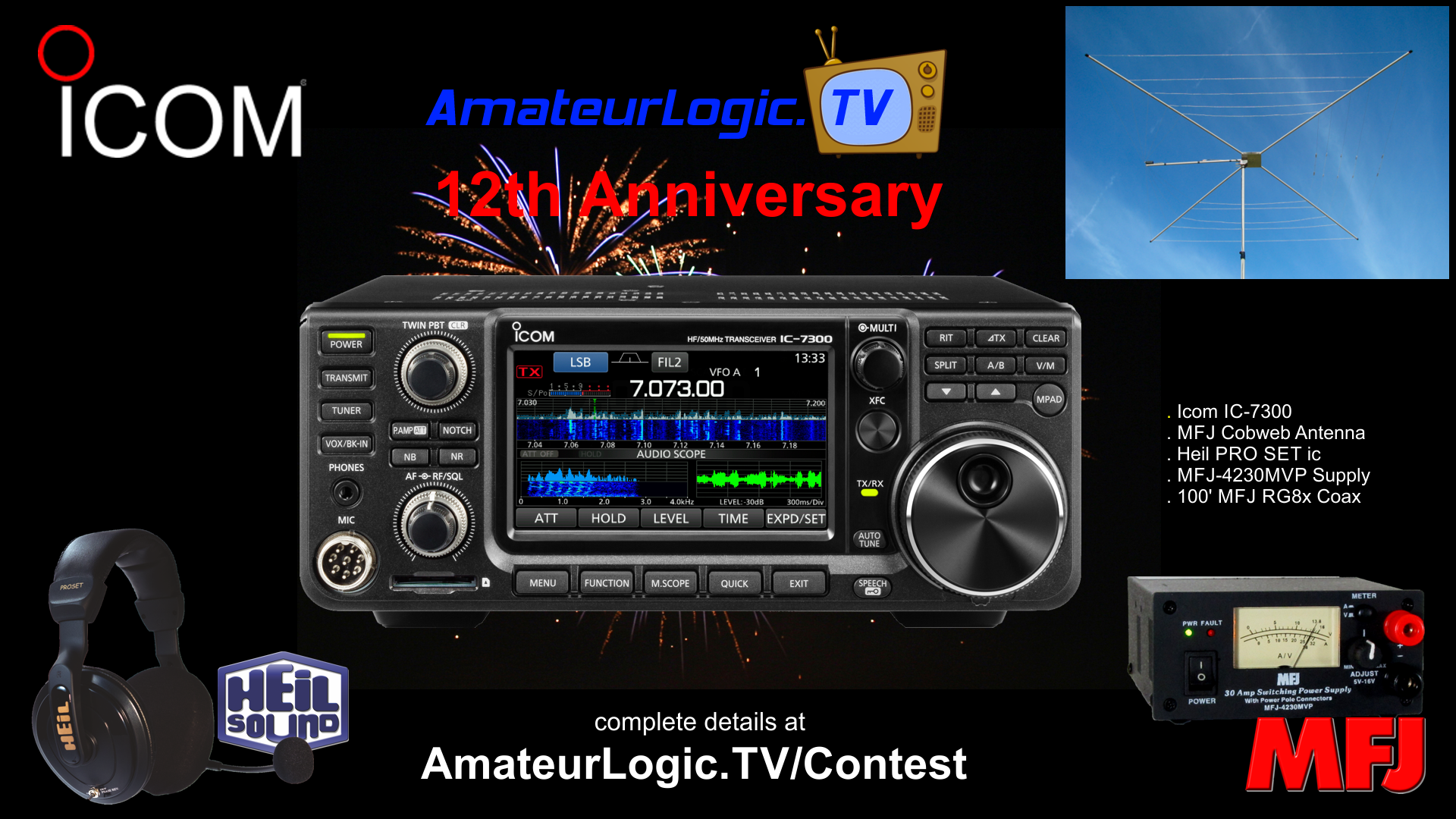 Get the complete details at: www.amateurlogic.tv/contest
Get the complete details at: www.amateurlogic.tv/contestGeorge Thomas, W5JDX, is co-host of AmateurLogic.TV, an original amateur radio video program hosted by George Thomas (W5JDX), Tommy Martin (N5ZNO), Peter Berrett (VK3PB), and Emile Diodene (KE5QKR). Contact him at [email protected].
 The VK3BVW Winter DX Survey
The VK3BVW Winter DX Survey
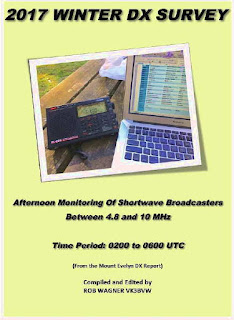 |
| courtesy: VK3BVW |
Every once in awhile I get the yen to tune through the international SW broadcast bands as my interest in good old, basic SWL'ing, is rekindled.
These bands are certainly quieter compared to when I first discovered the magic of radio and started DXing at age eleven using a lovely old all band cathedral-style GE set up in my attic-high radio shack ... no longer just a boring attic bedroom, but one with walls plastered with QSLs from all over the world.
 It was an amazing experience and one that obviously has left a lasting impression. There were hundreds and hundreds of stations on SW, throughout all of the HF bands but the highest I could tune was 19mc. on the old General Electric beauty ... who knows what was missed up higher as this was the peak of Cycle 19 and HF was on fire!
It was an amazing experience and one that obviously has left a lasting impression. There were hundreds and hundreds of stations on SW, throughout all of the HF bands but the highest I could tune was 19mc. on the old General Electric beauty ... who knows what was missed up higher as this was the peak of Cycle 19 and HF was on fire!As the huge decline in international SW broadcasting over the past few years continues, I'm always pleasantly surprised to see that there are still a lot of nice DX targets to hunt for.
I was particularly excited to read Rob's (VK3BVW) just released blogspot, describing his fall listening project from down-under. Being the DX season down in Australia, Rob decided to do daily bandscans of the low HF international SW bands (4.8 - 10MHz) to see what popped-up from day to day, which was actually afternoon to afternoon, since his listening was done between noon and 4PM local time. The project may be viewed here along with a nice introductory video ... in all, a huge effort by Rob with a lot of helpful details to go along with the logs.
While there be sure to visit the rest of Rob's SW blog ... there's a lot of good stuff here to get your SWL juices flowing!
His survey results are very encouraging for those of us that may have thought that there is just not much to be heard when it comes to international SW broadcasting. As Rob points out, even though these logs reflect what was heard in Australia, most, if not all should be hearable in North America as well, even more so as we approach the DX season in North America.
So pull up your chair sometime after dark, grab a cup of your favorite beverage, and take a relaxing tune through the SW bands with Rob's list in hand ... see what you can find, and perhaps rekindle that early fascination in SW radio outside of the ham bands that may have hooked you many years ago. You may also find this broadcast frequency database helpful should you run across something unknown.
Steve McDonald, VE7SL, is a regular contributor to AmateurRadio.com and writes from British Columbia, Canada. Contact him at [email protected].
 The VK3BVW Winter DX Survey
The VK3BVW Winter DX Survey
 |
| courtesy: VK3BVW |
Every once in awhile I get the yen to tune through the international SW broadcast bands as my interest in good old, basic SWL'ing, is rekindled.
These bands are certainly quieter compared to when I first discovered the magic of radio and started DXing at age eleven using a lovely old all band cathedral-style GE set up in my attic-high radio shack ... no longer just a boring attic bedroom, but one with walls plastered with QSLs from all over the world.
 It was an amazing experience and one that obviously has left a lasting impression. There were hundreds and hundreds of stations on SW, throughout all of the HF bands but the highest I could tune was 19mc. on the old General Electric beauty ... who knows what was missed up higher as this was the peak of Cycle 19 and HF was on fire!
It was an amazing experience and one that obviously has left a lasting impression. There were hundreds and hundreds of stations on SW, throughout all of the HF bands but the highest I could tune was 19mc. on the old General Electric beauty ... who knows what was missed up higher as this was the peak of Cycle 19 and HF was on fire!As the huge decline in international SW broadcasting over the past few years continues, I'm always pleasantly surprised to see that there are still a lot of nice DX targets to hunt for.
I was particularly excited to read Rob's (VK3BVW) just released blogspot, describing his fall listening project from down-under. Being the DX season down in Australia, Rob decided to do daily bandscans of the low HF international SW bands (4.8 - 10MHz) to see what popped-up from day to day, which was actually afternoon to afternoon, since his listening was done between noon and 4PM local time. The project may be viewed here along with a nice introductory video ... in all, a huge effort by Rob with a lot of helpful details to go along with the logs.
While there be sure to visit the rest of Rob's SW blog ... there's a lot of good stuff here to get your SWL juices flowing!
His survey results are very encouraging for those of us that may have thought that there is just not much to be heard when it comes to international SW broadcasting. As Rob points out, even though these logs reflect what was heard in Australia, most, if not all should be hearable in North America as well, even more so as we approach the DX season in North America.
So pull up your chair sometime after dark, grab a cup of your favorite beverage, and take a relaxing tune through the SW bands with Rob's list in hand ... see what you can find, and perhaps rekindle that early fascination in SW radio outside of the ham bands that may have hooked you many years ago. You may also find this broadcast frequency database helpful should you run across something unknown.
Steve McDonald, VE7SL, is a regular contributor to AmateurRadio.com and writes from British Columbia, Canada. Contact him at [email protected].
 Shortwave Radiogram
Shortwave Radiogram
The idea was anyone could receive the radiogram on any shortwave radio, even an inexpensive portable one with no SSB capability. By feeding the audio from the radio to a computer, either by a audio lead or even using the a microphone the listener could decode the text and images using simple software.
I had seen mention and reports on social media of people receiving them but somehow never got around to trying it myself.
VOA ended the experiment back in June this year a week before the retirement of the program producer Dr. Kim Andrew Elliott. An offer to continue the broadcasts on a contract basis was declined, so a follow-on show called Shortwave Radiogram began transmission from the WRMI Radio Miami International transmitting site in Okeechobee, Florida and Space Line in Bulgaria.
The Shortwave Radiogram transmission schedule is (at the time of writing and all times UTC)
Saturday 1600-1630 9400 kHz
Sunday 0600-0630 7730 kHz
Sunday 2030-2100 11580 kHz
Sunday 2330-2400 11580 kHz
All via WRMI except for 9400 kHz, which is via Space Line in Bulgaria.
I spotted a tweet a few weeks back (can't remember who from) mentioning the @SWRadiogram so my interest was piqued, I wasn't around for this weekends Saturday transmission in Europe but had a go on Sunday for the one from America. I wasn't expecting great things due to the levels of noise and poor conditions of late.
I have the decoding program FLdigi already installed on my computer for other datamodes and for information on how to decode the radiograms (sent using MFSK32) visit this page
On the 0600UTC transmission I managed just one poor image
but during the Sunday 2030UTC transmission I got four decent images, the fifth was lost to QRM
I also made two short videos (on hand held mobile phone so a bit shaky) which show the incoming text and images.
Andrew Garratt, MØNRD, is a regular contributor to AmateurRadio.com and writes from East Midlands, England. Contact him at [email protected].


